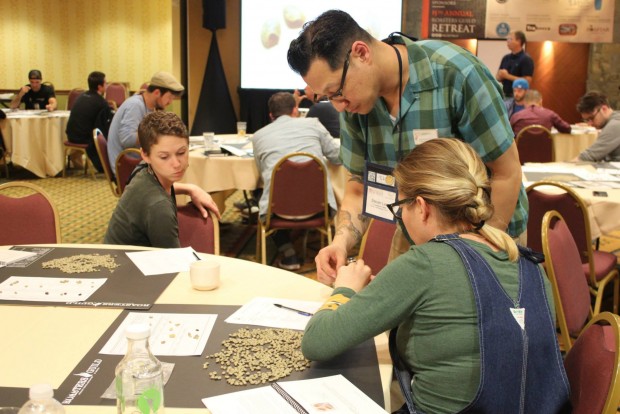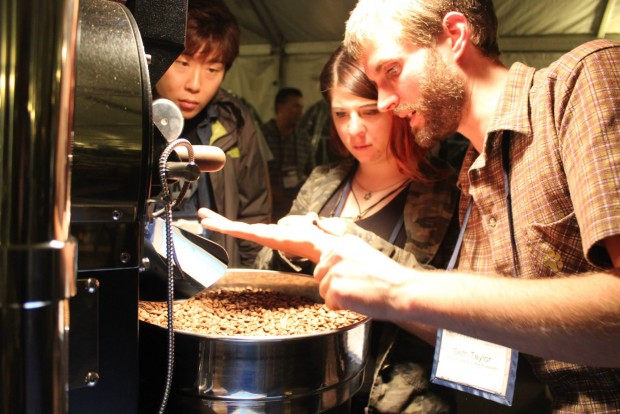
Coffee roasters and elite athletes just before running the Roasters Guild obstacle course. SCAA photo by Lily Kubota
Okay, south central Wisconsin is not exactly the northwoods, except perhaps in the eyes of certain summer vacationers from Chicagoland. But it was home to the 15th annual Roasters Guild Retreat this past weekend at the sprawling Lake Lawn resort in Delavan. (With big band music piping through the long corridors, it’s easy to believe the rumors that the resort was once a popular retreat among Chicago mobsters seeking respite from local heat during the prohibition era.)
The RG retreat, which annually sells out, was the guild’s largest to date, bringing together more than 200 coffee roasters to create relatively intimate clusters for learning, skill building and information sharing through formal education sessions, sample roasting and cuppings, and the annual roasting competition (which was this year won by Team 4 of 19, a.k.a. “The Maillards”).
With an amiable dry wit, current Guild Executive Council Chair Allen Leibowitz presided over the three-and-a-half day event, which, despite the participation of numerous sponsors and coffee/service/equipment providers, is intentionally non-salesy, nurturing collaboration in favor of competition. This was most evident in the roasting area, a marvel of on-the-fly event engineering in which some 20 roasting machines from eight manufacturers were humming away in unison with a remarkably effective ventilation system under an outdoor tent, while roaster reps stood patiently in the wings to ensure proper operation or offer assistance if requested.
While the event naturally offered coursework toward SCAA roaster certification — covering a range of topics including everything from fundamental roasting principles to understanding commodities futures contracts for high-volume buying — a broader educational focus throughout this year’s event was sensory analysis, with a more particular focus on quantitative analysis as opposed to qualitative analysis.
Presentations and cuppings led by SCAA Coffee Science Manager Emma Sage and Texas A&M sensory science expert Rhonda Miller, respectively, led tasters through the results of qualitative coffee analysis — that is to say, purely scientific analysis of flavor attributes of various brewed coffees, with none of the control or quality-concerned cupping forms or protocols traditionally used by coffee professionals. As one example, cuppers were given small water samples with added solutions to create various levels of bitterness or sourness, then subsequently given brewed coffees and asked to compare the coffee’s traits to the levels found in the controlled water solution. In short, the cuppings measured the intensity of primary and other flavor traits, with no interest paid to quality or desirability. Coffees were not scored; they were simply measured against non-coffee controls.
This analysis approach is associated with the flavor lexicon currently being developed by the pioneering coffee research group World Coffee Research, which was well-represented throughout the event, including a large seminar led by WCR Executive Director Tim Schilling and Communications Director Hanna Neuschwander, who filled retreaters in on several of the group’s ongoing and often interrelated short- and long-term initiatives in coffee supply sustainability.
The correlation between quantitative analysis (think science) and qualitative analysis (think industry) is currently difficult to define in practical terms. At the very least, these kinds of cuppings represented an extremely interesting intellectual exercise for people who have heretofore been trained to consider quality at every step. Yet Neuschwander, Miller and others involved suggested they may also help pave new roads to quality control and product consistency as the field of coffee analysis develops.
Nick Brown
Nick Brown is the editor of Daily Coffee News by Roast Magazine.










Comment